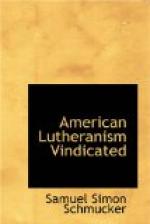“The Synods adopting this Platform are expected to make it a principle not to receive into their membership any one who will not subscribe this Definite Platform,” (meaning the whole pamphlet,) p. 6. On this subject the Platform was entirely misapprehended, by the readers not reflecting that the third resolution, on p. 6, must be construed in connection with the two immediately preceding and numerically connected with it. Resolutions first and second declare the “doctrinal Platform” to consist of the Apostles’ Creed, the Nicene Creed, and the American Recension of the Augsburg Confession, together with the General Synod’s Formula of Government and Discipline. And the third resolution adds, no one shall be received into this Synod who will not subscribe “this Platform,” namely, the one just defined. This American Recension or Revision of the Augsburg Confession, contains, unaltered, the doctrinal articles of that Confession, except, that a few sentences are omitted, and nothing added in their stead. Now, if it be admitted that when an enumeration of the parts of a whole is professedly and explicitly made, any thing not included in that enumeration is excluded, then certainly, as the first two resolutions enumerated specifically the Apostles’ Creed, the Nicene Creed, and the American Recension of the Augsburg Confession, as the parts constituting the Platform to which assent was required, it follows that the list of Symbolic Errors rejected, which is not named at all, and which formed a separate part of the pamphlet, is excluded. But the misapprehension evidently arose from the fact, that after the term doctrinal platform had been used in the work, to designate the doctrinal and disciplinarian basis contained in the first part of it, the name Definite Synodical Platform was selected for the whole pamphlet, and the distinction not kept up with sufficient prominence before the mind of the reader. This is remedied in the second edition, by employing the phrase Doctrinal Basis or Creed for the first, and “Synodical Disclaimer, or List of Symbolical Errors” for the second part. Moreover it is expressly stated, on p. 5, that “whilst we will not admit into our Synod any one who believes in Exorcism, Private Confession, and Absolution, or the Ceremonies of the Mass,” (not one of which is practiced, so far us we know, by a single minister connected with the General Synod),




